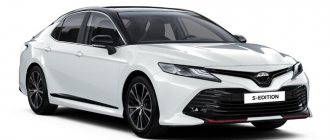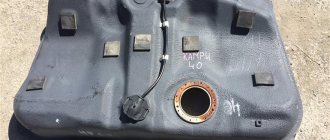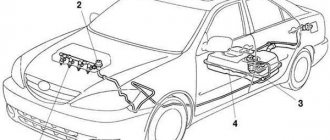The sixth generation of Toyota Camry was produced from January 2006 to 2011. In the CIS countries, the Camry 40 can be called a legendary car without exaggeration. There are a lot of them in every city and despite its advanced age, the Camry 40 remains desirable for many car enthusiasts.
Camry 40 is, without exaggeration, a cult car
Camry XV 40 before restyling
Why is the Toyota Camry XV 40 still popular and in demand? The answer is obvious: it is incredibly reliable. Even after traveling hundreds of thousands of kilometers with minimal attention from the owner, she is ready to ride again and again.
Another definite plus is the size of the Camry 40. This is a large sedan that is well suited for a small family. The features of the 2006 Camry include a spacious trunk, sufficient equipment and, which is not least important for our car enthusiast, solidity. This car does not have many chronic problems and solving them will not require large financial outlays from the owner of the “magpie.”
Exterior and body
The appearance of the Camry in the 40 body cannot be called bright and memorable. She doesn’t stand out in the crowd and passers-by are unlikely to turn to look at her. But at the same time, the design, despite the appearance of the next generation, does not seem outdated. The smoothed, rounded lines of the 2009 Camry hide the rather small size of the sedan. In general, the appearance of the “magpie” is discreet, respectable and quite attractive.
Like most Japanese cars, the body paint on the 6th generation Camry is not an example to follow. Chips and scratches appear easily, but the metal is well galvanized and these cars rarely rot, but time and reagents can take their toll, so be careful when buying a Camry supported one.
Other problems and malfunctions
The paintwork on the body is good, as is the hardware itself. Bare metal in places of chips is not prone to corrosion.
But the wiper arms quickly lose their presentation. Their coating swells after 2-3 years of use. Such phenomena sometimes occur with paintwork on wheel rims.
Toyota Camry VI (2006 -2009)
The only thing that can't resist corrosion is the filler tube. It can rot to holes in 12-13 years (5-6 thousand rubles).
On pre-restyling models, a crack sometimes appears in the lower part of the front bumper - exactly in the middle. It occurs even after light contact with an obstacle. The reason is an unsuccessful design - there is a seam that does not withstand loads well. It is treated by strengthening the problem area, for example, by applying a “splint” from the inside.
With age, headlights lose efficiency - the glazing becomes cloudy and the lenses burn out. To update the optics with the installation of LED modules, you will need 20-30 thousand rubles.
The interior of a business sedan is usually quiet and silent. In rare cases, the panels and driver's seat squeak. The leather on the seats, gear knob and steering wheel may lose its luster and become scuffed after 60 - 80 thousand km.
The air conditioner evaporator sometimes began to “spit dandruff.” This phenomenon occurred when the evaporator oxidized, which had to be replaced: 6-9 thousand rubles and 8-10 thousand rubles for work.
Toyota Camry VI (2009 - 20011)
The heater motor (from 5,000 rubles for an analogue) may become noisy after 200-250 thousand km.
From time to time it is necessary to update the steering column cable (2-4 thousand rubles).
The generator overrunning clutch (2-5 thousand rubles) could fail after 150 - 200 thousand km. Soon it was time for brushes, bearings and a diode bridge (from 1,500 rubles). A comprehensive repair of a generator will cost 4-10 thousand rubles.
Salon and interior equipment
Black Camry 40 interior with light wood grain accents. Agree, not the most beautiful option?
The 2006 Camry's interior is an excellent continuation of the exterior. It is just as uncomplicated and does not amaze the driver and passengers with its sophistications. At the same time, the simplest configuration is equipped with the necessary options.
The steering wheel of the Toyota Camry 2008 on the Russian market, even in the simplest Comfort configuration, is covered with leather and can be adjusted for reach and tilt. The seats do not have pronounced lateral support, but does the Camry 2007 need it, it is not a sports car or a hot hatchback.
Engine and gearbox
With engines and transmissions, the “magpie” has everything at the highest level. Engine volume 2.4 2AZ-FE 167hp. (gasoline, like the larger one) could be coupled with a 5-speed manual transmission or an automatic transmission with the same number of gears (U250E). With these combinations, reliability problems are very rare and are caused more by high mileage or improper maintenance than by a manufacturing miscalculation. This engine provides the Toyota Camry 2008 with decent dynamics in the city and on the highway. For a long and trouble-free life of the power unit and transmission, you need to change the oil in them in a timely manner, and they will continue to drive and drive.
Engine 2.4 2AZ-FE
More powerful V6 3.5 liter engine 277hp. 2GR-FE was paired only with a 6-speed automatic (U660E). This pair has problems with the automatic transmission: it is not designed for long-term aggressive driving, constant abrupt starts from a standstill, and with such merciless use, the powerful motor breaks its own box.
Camry XV40 fuel consumption
Both engines have acceptable appetite. The 2.4 engine consumes on average 10 l/100 km, consuming 13.5 in the city, and 7.8 l/100 km on the highway, which is quite low even by modern standards. Oddly enough, the manufacturer claims the same average fuel consumption of 10 l/100 km for the larger power unit, while the V6 3.5 consumes 14.1 liters of fuel in the city, and on the highway its appetite is 7.4. Such low figures are explained by the fact that the larger Camry XV 40 engine is equipped with a transmission with a large number of gears.
Chassis
Toyota Camry 2010 is built on the Toyota K platform with a fully independent spring suspension with MacPherson struts. Which ensures the legendary smoothness and softness. All elements of the 6th generation Camry suspension are very reliable and can easily last more than one hundred thousand kilometers. The brakes can only be disc, and they are, not to say, weak, but with an aggressive driving style, especially with a 277-horsepower engine, they require increased attention. The discs may suffer from overheating, and the caliper guides may become sour.
Black Camry - classic
When choosing a used Camry 2008, the condition of the brake system can become an indicator of the previous owner's attitude towards the car. If the braking system does not raise any questions, then the car was at least monitored, and maybe they did not try to set speed records.
Suspension
Toyota Camry with all-wheel drive
The chassis of the 40th Camry is reliable, with an average safety margin of 120-150 thousand km. Even such consumables as struts and stabilizer bushings last for 60-80 thousand mileage (in the original).
Sometimes when diagnosing the suspension it is not always clear where the knock is coming from, everything seems to be intact. In this case, you need to check the upper shock absorber mounts. Due to the tears, they knock quite noticeably.
In general, the Camry 40 suspension is “tailored” for comfort - soft and smooth. On this basis, many criticize the Camry 40 for poor handling. But it cannot be said that the car does not steer at all. Yes, it is not suitable for racing, but it was not created for racing. For normal city or highway driving, the Camry's handling is quite sufficient. Therefore, before buying, take a test drive to dispel all doubts.
Specifications
Body dimensions
In terms of its dimensions, the Toyota Camry 2008 belongs to the E class: length - 4815, height - 1480, width 1820 mm. In this case, the wheelbase is 2775 mm, the ground clearance is 160 mm. “Sorokovka” boasts a spacious trunk, the volume of which is 535 liters. with a 2.4 engine and 504 liters with a 3.5 engine. The fuel tank capacity is 70 liters. regardless of engine size. The weight of the car with different power units is also different: 1450 kg and 1540 kg.
Engine characteristics
The 2.4 engine (4-cylinder, 16-valve, DOHC, VVT-I, with timing chain drive) with the 2AZ-FE index produces 167 hp at 6000 rpm and 224 N/m at 4000 rpm and accelerates the Camry 2008 to 100 km/h in 10.2 seconds with an automatic (9.6 with a manual). The power of the V6 3.5 (with electronic fuel injection, timing chain drive, Dual VVT-I, 24 valves) with the 2GR-FE index is 277 hp at 6200 rpm, torque is 346 Nm at 4700 rpm. With this engine, the Camry XV40 reaches the first hundred in 7.4 seconds.
Security systems
Already in the basic Comfort configuration, the Toyota Camry 2007 was equipped with 6 airbags, ISOFIX mounts for child seats, active head restraints, and door stiffeners. Electronic safety and traffic control systems in the 6th generation Camry will definitely include:
- brake force distribution system (EBD),
- Brake Assist System (BAS).
More expensive trim levels also include:
- electronic stability control system (ESP),
- traction control system (TCS).
In the USA, crash tests were carried out according to the USNCAP system, according to the results of which the fortieth body received a rating of 5 stars.
Engines
Toyota camry
Officially in Europe, only two Camrys in the 40th body were sold - petrol 2.4 and 3.5 liters. Very rare are 2.0-liter (1AZ-FE, 145 hp) Camry VX40 imported from Asia (13 out of 1338 sales advertisements). On its basis, the most common for Camry 2006-2011 was created - the 2.4-liter (2AZ-FE, 158 and 167 hp), which we will consider in more detail below.
Another rare guest (25 out of 1338), at least for the Russian car market, is the 2.5-liter (2AR-FE, 179 hp). A more modern engine that has not lost Toyota reliability, which was installed on American cars. By the way, the same engine was installed on the next generation Camry XV50.
The hybrid Toyota Camry 40 is exotic. It is unlikely that you will find more than 5-6 current advertisements for sale. The second generation Hybrid Synergy Drive consists of a modified 2.4-liter gasoline engine (2AZ-FXE, 149 hp) and a 41 hp electric motor. In the case of a ten-year-old car, fuel savings may be questionable due to potential electrical complications.
Engine 2.4 liters (2AZ-FE, 158 and 167 hp)
One of the best representatives of the engine industry in terms of reliability. But this reliability has two bases:
- servicing every 10 thousand km is mandatory with high-quality oil (there are many options - discussion on the specialized forum) and filters;
- Regular cleaning of radiators of the cooling system.
Although the engine is reliable, it is still afraid of overheating. Overheating can be caused by clogged radiators. The overall temperature of the motor does not exceed 90 degrees. Therefore, just after the engine overheats, problems begin with leaking gaskets, antifreeze and breaking the threads of the cylinder block.
If the 2.4-liter engine is not overheated and serviced on time, then it will properly serve for at least 350-400 thousand km. You will only have to change the timing chain with tensioner somewhere between 200-250 thousand km. And don’t forget about adjusting the valves every 150 thousand mileage. This engine does not have hydraulic compensators, so the valves must be adjusted manually.
The weak point of the 2AZ-FE is the pump. The original water pump runs from 100 to 200 thousand km, depending on your luck. Signs of malfunction - it begins to make noise and leak. After the first replacement, most likely, you will have to change the pump every 50 thousand mileage.
V6 engine 3.5 liters (2GR-FE, 277 hp)
The engine runs great. Less than 7 seconds to one hundred kilometers is impressive. But it seems that 277 forces were crammed into the Camry VX40 with a reserve. The capabilities of the standard steering and braking system are not enough to unlock the full potential of the 3.5-liter engine. But this is not always necessary. For many, it is enough to have a reserve of power under the gas pedal. Under Russian legislation, this stock is expensive due to transport tax.
There are much fewer forties Camrys with such engines on sale - about 23% (316 out of 1338). Most of them were bought by riders. And increased power and an aggressive driving style have a detrimental effect on the service life of the six-speed automatic.
Therefore, before purchasing a Camry 3.5, a particularly thorough diagnosis of the engine and gearbox is necessary. You can even check cylinder 5 using a flaw detector for scoring. Such a nuisance can occur after the engine overheats and threatens a complete overhaul of the power unit.
On cars produced before 2010, there was a recall campaign due to composite oil cooler pipes and the VVTi system. They were replaced with completely metal ones. Check, and if your car has old-style pipes, be sure to replace them. In the event of a breakthrough, all engine oil flows out within 10 minutes.
Otherwise, with good maintenance, the safety margin of the 2GR-FE is even greater than that of the younger 2.4-liter engine. And with a difference in power of more than 100 hp. With. Gasoline consumption is practically the same. Unless, of course, you turn on the “rocket” driving mode.
The pump is also not particularly durable, and the valves will have to be adjusted more often - once every 100 thousand km. Please note that the cost of this procedure on a six-cylinder engine is significantly more expensive.
Toyota Camry XV40 sedan configurations
There were 5 trim levels of the Toyota Camry 2008 presented on the Russian market. All of them were equipped only with gasoline engines and front-wheel drive (in other markets there were all-wheel drive and hybrid versions).
The most affordable - Comfort (R1)
with a 2.4 engine and manual transmission was not poorly equipped:
The beige interior with light inserts is not bad at all
- The leather steering wheel is adjustable in two planes,
- 6 airbags,
- brake force distribution system,
- auxiliary braking system,
- immobilizer,
- central locking,
- heated and electrically adjustable side mirrors,
- Rain sensor,
- on-board computer,
- CD changer,
- MP3 format support.
The next configuration is also called Comfort (R2)
, its difference from the basic version is the presence of an automatic transmission and headlight washers.
Equipment Elegance (R3)
In addition to the available options, the Toyota Camry 2009 boasts leather trim, electric front seats and parking radars.
Prestige (R4)
– the most expensive configuration with the 2.4 engine has cruise control, electronic stability control (ESP), traction control system (TCS) and xenon headlights.
Luxury (R5)
In addition to the more powerful V6 3.5 engine, the owner is pleased with the adjustment of the rear sofa in the longitudinal direction and the ability to select the required tilt of its backrest, the steering wheel and automatic transmission selector are trimmed in wood, and there is a rear window sunshade.
6th generation review
High-quality interior of the 40th body
Most of the versions that dominate the market now are dealer versions. Their production has been established in Russia since 2008, and they are well adapted to local conditions. There are also quite a few copies exported from the Middle East and the USA on the secondary market.
But this option is not worth taking, since they have weak anti-corrosion treatment. The climate system and cooling are designed for hot climates.
Toyota Camry V40 sedans were sold in Russia, well adapted to the road conditions of our country.
All models are distinguished by a rich set of equipment:
- the basic Comfort model has 6 airbags, climate control, air ionizer;
- Comfort Plus was equipped with a five-speed gearbox;
- Elegance has leather seats and parking radar;
- Prestige – it has cruise control, xenon headlights and stability control;
- Luxury – equipped with a six-speed gearbox, V6 engine
The Toyota Camry 40 body is loved by domestic motorists and in its class has a large lead in sales compared to competitors, not having the best driving performance or design in its class.
Toyota Camry with a powerful V6 3.5 engine.
The machine is popular due to its high quality workmanship and durability. This model has low maintenance costs, is easy to repair and can be sold quickly at a good price.
Restyling 2009
External changes affected the turn signal indicators, which moved from the front fenders to the mirrors, the design of the foglights and the radiator grille. The interior trim has also undergone minor changes: the color of the plastic on the center console has been replaced from blue to silver. In expensive trim levels of the Toyota Camry 2009, it became possible to connect the car with gadgets via Bluetooth, and the monochrome display was replaced with a color touch monitor with the ability to display navigation; the multimedia also acquired a 10 GB hard drive.
Disadvantages of the Toyota Camry in the XV40 body
Engine V6 3.5 2GR-FE
The Sorokovka is a great car, but there are no perfect cars, so even it has its flaws. Some car enthusiasts consider the lack of a diesel engine and station wagon form factor, extremely soft suspension and weak lateral support for the seats of the sixth generation Camry to be disadvantages. But this is not a miscalculation of the engineers - this is the philosophy of the Camry 2011.
The troubles that await you in the cabin include: insufficiently wear-resistant seat upholstery materials, both fabric and leather, the button coating is also not known for its durability, which quickly wears off, squeaks often appear, sound insulation is not the standard for cars of this class.
If you take sufficient care of the car and observe maintenance intervals, the Toyota Camry 2006 is unlikely to surprise you with technical malfunctions and problems. But there are units that require increased attention from the owner. The Camry ACV40 automatic transmission with a 3.5 engine requires frequent oil changes, but this will not protect it from breakdown if the driving style is too aggressive. A V6 engine can overheat due to a leaky coolant hose; this problem was eliminated in restyled cars by replacing the hose with a metal tube.
Both engines run only on synthetic oil; prolonged use of the other can lead to damage to the VVT-I couplings. Refueling with frankly bad fuel will cause the oxygen sensor to fail.
There are a large variety of Toyota Camry 40 car configurations on the domestic market. In this article we will tell our readers about what configurations the Camry 40 comes in, consider their technical characteristics and, of course, prices for cars of different configurations.
First of all, it is worth saying that the Camry 40 generation has been on the market for a very long time - from 2006 to 2011. This presentable car with a large sedan-type body appealed to many. A little later, the 40 model was replaced by a new model - the Camry XV50. At the same time, the production of the fortieth model continued for some time.
ATTENTION! A completely simple way to reduce fuel consumption has been found! Don't believe me? An auto mechanic with 15 years of experience also didn’t believe it until he tried it. And now he saves 35,000 rubles a year on gasoline!
Due to the long production period of the model, during a certain period of time, namely in 2007 and 2009, some vehicle configurations underwent certain changes. Cars produced since 2009 have been completely restyled, which, according to auto experts, has had a positive effect on the operation of the car: common problems and “sores” of cars have been eliminated, the appearance has changed slightly, and the interior has also been slightly redesigned.
Spacious interior comfort
There is a lot of free space inside, passengers sit on cool, soft leather chairs. The front row is electrically adjustable in good trim levels and is heated. The rear may also be heated, and top trim levels even had an 8-degree backrest tilt adjustment.
Inside there is everything you need, from a multimedia screen that supports navigation to separate climate control. There is no point in dwelling on the equipment; it would be better to describe the equipment separately.
Leather is predominantly used as lining, but the manufacturer did not skimp on plastic parts, and added wooden elements for decoration. The leather upholstery of the Toyota Camry 40 after 150 thousand begins to actively lose its presentation. Breaks are rare, but breaks and serious abrasions are common. The power seat adjustment works great, but sometimes the wiring fails.
Plastic elements, including the rear part of the steering wheel, begin to squeak over time. It’s better to do it, otherwise what’s the point of good sound insulation if there is another, internal sound source. By the way, the Shumka field of 200 thousand is no longer so steep, because the seals are worn out. Decorative wooden inserts do not withstand the climate, losing their external varnish.
In addition to the creaking of the plastic steering column, frequent sharp turns interrupt the wiring, causing the steering wheel buttons to fail. Toyota organized a recall company to replace power windows - problems occurred, and they also changed the floor mats, since the driver could press the gas pedal.
Statistics of used Camry 40 by trim levels
If we limit the search area for Camry 40 to the territory of the Russian Federation and the CIS, we can analyze and conclude that the most popular models are those equipped with a 2.4 engine with 167 horsepower and an automatic transmission. Slightly less common are examples with an engine capacity of 3.5 liters with 277 horsepower and an automatic transmission.
An even smaller market share is occupied by models with a 2.4 engine and manual transmission. There are also rarer combinations of units found throughout the Russian Federation and the CIS - a 3.5 engine and a manual. And the very apogee of exclusivity for the domestic market is the configuration of the American Camry 40 with a 2.5-liter internal combustion engine and automatic transmission, as well as cars with hybrid units.
Nevertheless, it is possible to find Camry 40 of these rare configurations on the domestic market; most often they can be found in the eastern part of the Russian Federation. This is where most of the rare models come from, since they come to the country from the “homeland” of origin of the Toyota brand. Hybrid models are intended for the Japanese domestic market and are not officially supplied to the Russian Federation and the CIS. The most popular models are produced within the country, for the Russian Federation - a plant in St. Petersburg. So finding a domestically assembled model is not difficult. Camry 40 of domestic production has appeared on the market since 2008. Differences between units between models depending on configurations
In the article we will not consider the most rare and exclusive configurations, since they are not intended for domestic use; we will concentrate on the most common models and their equipment. So, the configurations can be divided depending on the year of manufacture, for example, there are 5 of them on pre-restyling versions, and 6 on restyled versions:
- Comfort (or R1).
- Comfort + (or R2).
- Elegance (or R3).
- Prestige (or R4).
- Luxe (or R5).
On the restyled versions, another configuration appeared - Elegance+.
Now let's look at what the configurations can boast of, and what a car in one configuration or another can offer the car enthusiast.
If we talk about the units installed in Toyota Camry 40 cars, they are as follows:
- all pre-restyling vehicle configurations, starting with Comfort (R1) and ending with Prestige (R4), are equipped with 2.4 engines and automatic transmission, there is also a lower Comfort configuration with a 2.4 engine and manual transmission;
- The Luxe (R5) package is equipped with a more powerful 3.5 engine and automatic transmission;
- restyled models have exactly the same power equipment as the pre-restyle version, for models starting with the Comfort version and ending with the Prestige version - 2.4 automatic transmission, the version with manual transmission has the simplest electrical equipment and is supplied only in the Comfort package (R1);
- The richest equipment for the restyled model is Luxe, it has a 3.5 engine and automatic transmission.
Technical stuffing
Engines 2.4 and 3.5 V6
Dealer models were equipped with gasoline engines: a four-cylinder with a volume of 2.4 liters (167 horsepower) and a six-cylinder V-shaped (277 horsepower).
They have a strong chain in the gas distribution mechanism drive with the ability to adjust the VVT-i phases. Their valve apparatus can be adjusted by selecting washers. This operation should be carried out after the car has traveled 150 kilometers. Typical engine malfunctions include the fact that in cars of this series, closer to 100 thousand kilometers, the generator pulley begins to turn. This part can be replaced, the unit will continue to serve.
Transmission
The 2.4-liter Toyota Camry engine in the 40 body goes well with a five-speed automatic and manual transmission.
The six-cylinder V6 was equipped with a six-speed automatic transmission. The mechanical option is considered the most reliable. In the interval from forty to sixty kilometers, significant effort is required to change gears due to early wear on the clutch release bearing, which has a release function.
The Aisin U250E six-speed manual transmission has proven to be a reliable mechanism during operation. It can be easily repaired; there is no need to rush to change it completely. It is enough to replace some parts, such as the limit switch and the contact in the control unit.
The six-speed Aisin U250E gearbox is also considered quite reliable. Its service life is largely determined by driving style. During aggressive driving, premature wear of the clutches occurs, and the valve body channels become clogged with decay products. The cost of its repair can reach eighty thousand.
The oil must be changed more often than recommended (every 80 thousand km). During this period, the external CV joints begin to knock; they come complete with the axle shafts.
Chassis
The suspension of the Toyota Camry 40 is borrowed from previous models of the V30 variety. It is highly durable. The stabilizer bushing is the first to suffer in the range of up to 80 km. Wear and tear of silent blocks includes levers, which are replaced at about 130 km.
Ball joints and shock absorbers maintain their integrity up to 200 km. The shock absorbers and transverse rear arms will last for about the same time; the rear suspension may need to be rebuilt.
The running gear of this model did not reveal any other problem areas. Stabilizer bushings remain in working condition in the range from 55 to 80 thousand. The remaining parts usually do not fail. But in the brake system, the discs in the front wear out relatively quickly. They become deformed during sudden braking. The calipers also become sour; it is recommended to lubricate them at every maintenance.
The steering shaft universal joint wears out ahead of schedule. There have been cases of oil seals and high-pressure hoses leaking in the power steering pump. Steering rods can withstand mileage up to 130 thousand km. The rack is good for over 200 thousand mileage.
Description of Toyota Camry 40 configurations
Let's start with the most basic configuration - the Comfort version (R1). There is no way to call her “poor”. In the “Comfort” version (R1) the car receives:
- ICE 2.4 and manual/automatic transmission;
- full power accessories (electric windows with closers, central locking, heated electric mirrors with automatic folding, rain sensor, light sensor);
- power steering, four-position adjustable steering column;
- fog lights;
- remote control of central locking, alarm system and standard immobilizer;
- 2 front and 2 side airbags;
- advanced driver assistance systems: ABS + EBD (brake force distribution), Brake Assist;
- dual-zone climate control and air ionizer;
- The instrument room is equipped with Optitron type lighting;
- the audio system has 6 speakers and a separate CD/DVD changer for 6 discs;
- leather multifunction steering wheel, not heated;
- The interior in the “Comfort” configuration is trimmed with velor, and the lining is made of wood-like plastic.
Since 2007, cars have received an additional option - heated front seats.
The improved version “Comfort +” (R2) received very few improvements compared to the R1 version:
- 5-speed automatic transmission;
- headlight washers.
The Elegance version (R3) also received minor differences from the two previous trim levels:
- front seats, electrically adjustable in 4 positions;
- exchange rate stabilization system - VSC;
- system preventing wheel slip - TRC;
- parking sensors;
- The interior in the “Elegance” configuration is trimmed with leather, the linings are still made of wood-like plastic.
The Prestige version (R4) received the following changes:
- multi-function display on the front panel;
- xenon headlights;
- navigation system (for restyled models - with voice control);
- Rear View Camera;
- Cruise control.
And finally, the richest package - “Lux” (LE/R5). In this configuration, the car has undergone major changes and new features have been added to the previous ones, such as:
- powerful internal combustion engine - 3.5 l (V6) and 6-speed automatic transmission;
- leather multifunction steering wheel with real wood inserts;
- leather gear selector with natural wood trim;
- smart car access system - Smart Entry;
- smart engine starting system - Push Start;
- the changer gave way to a 10GB multimedia system;
- the rear row of seats can be adjusted;
- automatic rear window blind.
If we take the restyled models, then the external body elements (bumpers and sills) and partly the plastic in the interior have undergone changes. Among the significant changes that differ from the pre-restayle:
- xenon headlights for the Elegance+ package (R4 - restyling);
- multimedia system with display, starting with Elegance (R3) trim levels;
- keyless “smart” access - Smart Entry and engine start - Push Start.
American and Arab women
Toyota Camry VIII XV70 2018
There are very few such cars in Russia. But in Belarus, Kazakhstan and Ukraine, the percentage of such Camry V40s on sale is quite high. There are differences between cars for the American market and the European/Russian market, but they are not fundamental. They mainly concern configurations.
The “Americans” have different front optics and there are no turns on the front wings even before the restyling. The bulk of the cars are delivered in the basic LE configuration. The main difference from Europe is the lack of climate control, only air conditioning. Many owners note the poor quality of upholstery and plastics in the cabin before restyling. After 2009, the quality of interior trim became equal.
American XLEs are less common. There may already be navigation, and starting the engine with a button and good JBL music. The American cars have a softer suspension. Another significant difference is that it can be equipped with a 2.5-liter gasoline engine. The same ones have already been installed on the Camry 50.
The “life” and service history of any “American” can be checked using the CARFAX service.
With the “Arabs” it’s a little sadder. In these parts they are overwhelmingly used by taxi drivers. This also applies to Australian cars. Moreover, they have the same configurations. Most often, this is a “naked” GL, which doesn’t even have an optical instrument panel. And before sale, such Camrys drive 400-500 thousand km, which our craftsmen easily turn into 150-200 thousand km.
The top-end Arab GLX and SE are better equipped, but they are harder to find, and the price difference with the European Camry is not so interesting.
Bottom line
As you can see from the article, the Camry 40 is a worthy car for pragmatic people. It does not require large financial investments, and the variety of trim levels will allow you to choose exactly the version of the car that will meet all the comfort requirements of a potential buyer.
Prices for the most basic model on the market (pre-restyle) start from 650,000 rubles, for restyling you will have to pay about 800,000 rubles. Prices for the top-end LE (pre-restayl) configurations start from 1 million and above. For restyled versions, prices are even higher - from 1.25 million rubles.
, Mitsubishi, Citroen, UAZ, Lifan, Chery, FAW, Chrysler. 12 dealer centers located in Moscow and Moscow Region are as accessible and convenient as possible for customers to visit.
The AutoHERMES team of professionals has achieved success, winning recognition from car owners and the business community as a reliable partner. We receive only positive feedback from our clients. Buying a car from an official AutoHERMES dealer is a guarantee of reliability!
Sale of new cars through the Trade-in system in Moscow
Exchange your used car for a new one at our car dealerships using the convenient Trade-In system or use the car buy-back service.
The main advantages of exchange in the AutoHERMES salon:
- We accept cars of any brand, regardless of year of manufacture and mileage;
- We provide assessment and diagnostics free of charge;
- Your car can become a down payment on a loan;
- We offer a large selection of cars for exchange.
Also with us you can evaluate and put your car up for sale, receiving its maximum value in the minimum time.










